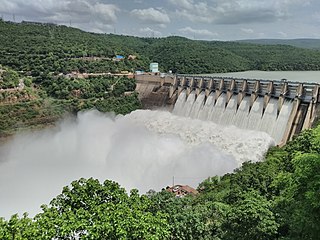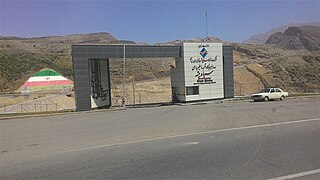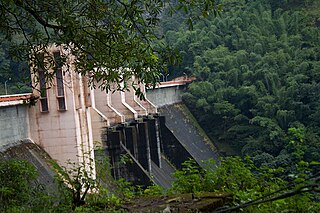This article needs additional citations for verification .(January 2010) |
The Dehani lift irrigation scheme is a technologically sophisticated project to irrigate Vidarbha, a large, semi-arid region of India.
This article needs additional citations for verification .(January 2010) |
The Dehani lift irrigation scheme is a technologically sophisticated project to irrigate Vidarbha, a large, semi-arid region of India.
Vidharba is a semi-arid region that has an ailing agricultural community which has huge amounts of debts. This has led to a high farm suicide rate. [1] The Prime Minister has proposed a centrally funded package to irrigate nearly 7,000 hectares (27 sq mi) and therefore provide economic relief.
The project is being executed by Vidarbha Irrigation Development Corporation and IVRCL Infrastructures and Projects Limited. The region to be irrigated is 6,968.01 hectares (26.9036 sq mi) in Dehani, Babhulgaon taluk, Yavatmal district, over the river Bembla at Khadasawanga. The project costed INR 1,988,300,000 (1.988 billion) [2] and was completed in 2011.
This project was the first of its kind in India [3] and envisions the drip irrigation of a large area, while making use of the latest in communication technology. The Supervisory Control and Data Acquisition System (SCADA) will interconnect all components of the system via a satellite uplink, making it possible for the central command centre of the irrigation scheme to be able to control all components remotely.
The Bembla dam built over the river Bembla at Khadaksawanga is 7,650 metres (8,370 yd) long and 29.15 metres (95.6 ft) high, with a capacity of 322,068,000 cubic metres (421,249,000 cu yd). The Bembla project currently has a command area of 40,170 hectares (155.1 sq mi), and the completed project will have a command area of 52,543 hectares (202.87 sq mi). The total project cost is expected to be INR 12.8 billion. [4]
A 1,700-metre (5,600 ft) approach channel carries water from the Bembla reservoir into the Forebay Stage-1. The channel is of trapezoidal cross-section. [5]

The forebay is 40 metres (130 ft) long and has an average depth of 12 metres (39 ft). This structure functions as a storage space for water before it is pumped farther ahead. [5]
This pumphouse is attached to the Forebay Stage-1 and has vertical turbine pumps with an installed capacity of 4,800 hp (3,600 kW). Water is pumped from a reduced level of 265 metres (869 ft) to the Main Distribution Chamber Stage-1 up to an elevation of 304 metres (997 ft) via the Rising Mains Stage-1, which consist of one row of 1,700 mm (67 in) steel pipe and one row of 900 mm (35 in) steel pipe. [5]

From MDC Stage-1, part of the water enters the forebay of Pumphouse Stage-2, which has an installed vertical turbine pump capacity of 1,640 hp (1,220 kW). The remainder of the water is supplied to 34 Sub Distribution Chambers via pre-stressed concrete pipes which form part of the Gravity Mains. [5]
Each SDC is a circular underground tank with a capacity of 150,000 litres (40,000 US gal). The average depth of each SDC below the ground level is 5–6 metres (16–20 ft). Each will service an area of 100 hectares (250 acres). [5] Each SDC, along with its associated instrument panel room and transformer, has been allocated a 20 by 20 m (66 by 66 ft) area.
Each SDC has a 100 horsepower (75 kW) pump installed. A trained operator will be employed in each instrument panel room to make the relevant data entries regarding the type of crops on the sub-zones being serviced by that particular SDC. The programme distributes the exact amount of water required in each sub-zone and cuts off the flow when the requirement has been fulfilled.
The entire project has been divided into two stages, the first stage consists of 34 SDCs and the second stage consists of 23 SDCs. In all there will be 57 SDCs servicing the 57 zones that are subdivisions of the command area. Each zone is to be divided into 27 sub-zones. The SCADA system to be implemented is capable of delivering the exact amount of water required at each field according to the cropping pattern. It is proposed to train three representatives of the farming community from each zone, so that they will be able to operate the instrument panel of each SDC. For the initial three years of functioning, the IVRCL personnel will run the entire project, after which the responsibility of the day-to-day activities at the SDC will be handed over to the representatives of the farming community.
Part of the water stored in the MDC Stage-1 is supplied into this forebay. From here 1,640 horsepower (1,220 kW) vertical turbine pumps (installed in the Pumphouse Stage-2) are used to pump the water farther ahead into the second stage of the project serviced by MDC Stage-2, which will supply 23 more SDCs. [5]

The Alqueva Dam is an arch dam and the centrepiece of the Alqueva Multipurpose Project. It impounds the River Guadiana, on the border of Beja and Évora Districts in south of Portugal. The dam takes its name from the town of Alqueva to its right bank. It creates a large reservoir with an inter-annual regulation capacity from which water may be distributed throughout the region. The dam was completed in 2002 and its reservoir reached the full level, for the first time, in 2010. The 518.4-megawatt (695,200 hp) power station was commissioned in two stages, stage I in 2004 and stage II in 2013. The Alqueva Dam is the largest dam and artificial lake in Western Europe.

GandhisagarDam is situated at a distance of 168 km from the District headquarter. The Dam is constructed on the Chambal River.

Nagarjuna Sagar Dam is a masonry dam across the Krishna River at Nagarjuna Sagar which straddles the border between Palnadu district in Andhra Pradesh and Nalgonda district in Telangana. The dam provides irrigation water to the districts of Palnadu, Guntur, Nalgonda, Prakasam, Khammam, Krishna, and parts of West Godavari. It is also a source of electricity generation for the national grid.

The Robert-Bourassa generating station, formerly known as La Grande-2 (LG-2), is a hydroelectric power station on the La Grande River that is part of Hydro-Québec's James Bay Project in Canada. The station can generate 5,616 MW and its 16 units were gradually commissioned between 1979 and 1981. Annual generation is in the vicinity of 26500 GWh.

The Robert Moses Niagara Hydroelectric Power Station is a hydroelectric power station in Lewiston, New York, near Niagara Falls. Owned and operated by the New York Power Authority (NYPA), the plant diverts water from the Niagara River above Niagara Falls and returns the water into the lower portion of the river near Lake Ontario. It uses 13 generators at an installed capacity of 2,525 MW (3,386,000 hp).

The Haditha Dam or Qadisiya Dam is an earth-fill dam on the Euphrates, north of Haditha (Iraq), creating Lake Qadisiyah. The dam is just over 9 kilometres (5.6 mi) long and 57 metres (187 ft) high. The purpose of the dam is to generate hydroelectricity, regulate the flow of the Euphrates and provide water for irrigation. It is the second-largest hydroelectric contributor to the power system in Iraq behind the Mosul Dam.
The Temengor Dam or Temengor Hydro-Electric Project or Temengor Power Station is a dam in Gerik, Perak, Malaysia. It is located on Perak River about 200 km northeast of Ipoh. Construction of the dam impounded Temenggor Lake.

The Guangdong Pumped Storage Power Station or Guangzhou Pumped Storage Power Station is a pumped-storage hydroelectric power station near Guangzhou, Guangdong Province, China. Power is generated by utilizing eight turbines, each with a 300 megawatts (400,000 hp) capacity, totalling the installed capacity to 2,400 megawatts (3,200,000 hp). The generated power is sold to CLP customers in Hong Kong. The power station was constructed in two stages, the first four turbines were completed in 1994 and the second four in 2000.

The Srisailam Dam is constructed across the Krishna River in Nandyal district, Andhra Pradesh and Nagarkurnool district, Telangana near Srisailam temple town and is the 2nd largest capacity working hydroelectric station in India.

Talbingo Dam is a major ungated rock fill with clay core embankment dam with concrete chute spillway across the Tumut River upstream of Talbingo in the Snowy Mountains region of New South Wales, Australia. The impounded reservoir is called Talbingo Reservoir.

Ujjani Dam, also known as Bhima Dam or Bhima Irrigation Project, on the Bhima River, a tributary of the Krishna River, is an earthfill cum Masonry gravity dam located near Ujjani village of Madha Taluk in Solapur district of the state of Maharashtra in India.

Jayakwadi dam is an earthen dam located on Godavari river at the site of Jayakwadi village in Paithan taluka of Sambhajinagar district in Maharashtra, India. It is a multipurpose project. The water is mainly used to irrigate agricultural land in the drought-prone Marathwada region of the state. It also provides water for drinking and industrial usage to nearby towns and villages and to the municipalities and industrial areas of Sambhajinagar and Jalna districts. The surrounding area of the dam has a garden and a bird sanctuary.

The Ponmudi Dam is a concrete gravity dam built across the Panniyar river which is a tributary of Periyar river at Konnathady panchayath of Konnathadi village in Idukki district of Kerala, India. The dam was constructed in 1963 as a part of a hydroelectric project. Construction was led by E.U.Philipose, Superintending Engineer, Kerala State Electricity Board. It has a length of 288.80 metres (947.5 ft). The hydropower component of the dam has an installed capacity of 30 MW with firm power of 17 MW, generating 158 GWh annually. Taluks through which the river flow are Udumbanchola, Devikulam, Kothamangalam, Muvattupuzha, Kunnathunadu, Aluva, Kodungalloor and Paravur.

The Siah Bisheh Pumped Storage Power Plant, also spelled Siyāhbisheh and Siah Bishe, is located in the Alborz Mountain range near the village of Siah Bisheh and 48 km (30 mi) south of Chalus in Mazandaran Province, Iran. The power plant uses the pumped-storage hydroelectric method to generate electricity during periods of high energy demand, making it a peaking power plant, intended to fulfill peak electricity demand in Tehran 60 km (37 mi) to the south. When complete it will have an installed generating capacity of 1,040 megawatts (1,390,000 hp) and a pumping capacity of 940 megawatts (1,260,000 hp). Planning for the project began in the 1970s and construction began in 1985. It was delayed from 1992 until 2001 and the first generator went online in May 2013. The remaining generators were commissioned by 1 September 2015. The power plant is the first pumped-storage type in Iran and will also use the country's first concrete-face rock-fill dam – two of them.

Rangit Dam, which forms the headworks of the Rangit Hydroelectric Power Project Stage III, is a run-of-the-river hydroelectric power project on the Ranjit River, a major tributary of the Teesta River in the South Sikkim district of the Northeastern Indian state of Sikkim. The project's construction was completed in 1999. The project is fully functional since 2000. The project was built at a cost of Rs 4922.6 million. The average annual power generation from the 60 MW project is 340 GWh with firm power of 39 MW.

Idamalayar Dam is a multipurpose concrete gravity dam located at Ennakkal between Ayyampuzha and Bhoothathankettu in Ernakulam district of Kerala on the Idamalayar, a tributary of the Periyar River in Kerala, South India. The dam however extends east as far as Malakkappara. Completed in 1985, with a length of 373 metres (1,224 ft) and a height of 102.8 metres (337 ft), the dam created a multipurpose reservoir covering 28.3 km2 (10.9 sq mi) in the scenic hills of the Anamalais.

The Aras Dam is an embankment dam on the Aras River along the border of Iran and Azerbaijan. It is located downstream of Poldasht in West Azerbaijan Province, Iran and Nakhchivan City in Nakhchivan Autonomous Republic, Azerbaijan. The primary purpose of the dam is hydroelectric power production and water supply.

The Bhumibol Dam is a concrete arch dam on the Ping River, a tributary of the Chao Phraya River, in Sam Ngao District of Tak Province, Thailand. It is about 480 km (298 mi) north of Bangkok and was built for the purposes of water storage, hydroelectric power production, flood control, fisheries and saltwater intrusion management. The dam was named after King Bhumibol Adulyadej and it was Thailand's first multi-purpose project. It is the highest dam in Thailand at 154 m (505 ft) tall.
Lakhwar-Vyasi Dam project on Yamuna River, includes under-construction Lakhwar Dam and Power Station, Vyasi Dam, Hathiari Power Station and Katapathar Barrage, near the Lakhwar town in Kalsi block of Dehradun district of Uttarakhand in India, for the purpose of irrigation of 40,000 hectare land and total 927 MW hydroelectric power generation. "Lakhwar Dam" is a gravity dam near the Lohari village with 300MW power generation capacity. "Vyasi Dam" will be built 5 km downstream along with 120 MW "Hathiari Power Station" further 0.5 km downstream. "Katapathar Barrage", with the maximum ponding water level at 514.5m elevation, will be built further 2.75 km downstream of the Hathiari Power Station to supply the water to stakeholder states. Project will hold 580 million cubic metres water during monsoon and release into Yamuna during dry months.
The Meander Dam is a concrete gravity dam across the Upper Meander River, located in northern Tasmania, Australia. The impounded reservoir is called Lake Huntsman.
{{cite web}}: Missing or empty |title= (help)[ dead link ]{{cite web}}: Missing or empty |title= (help)[ dead link ]